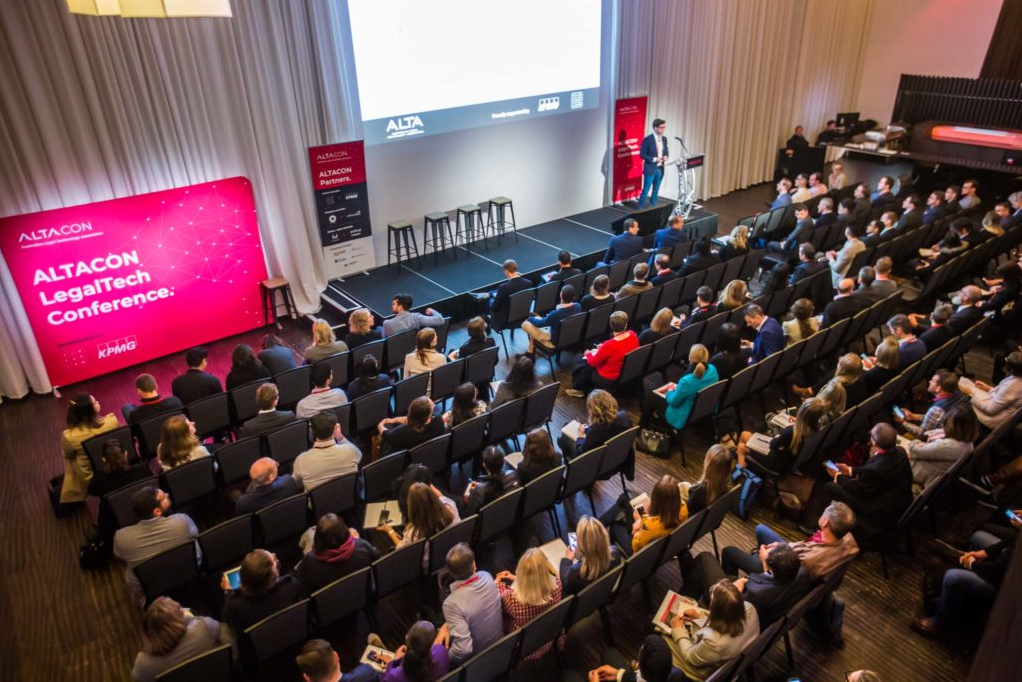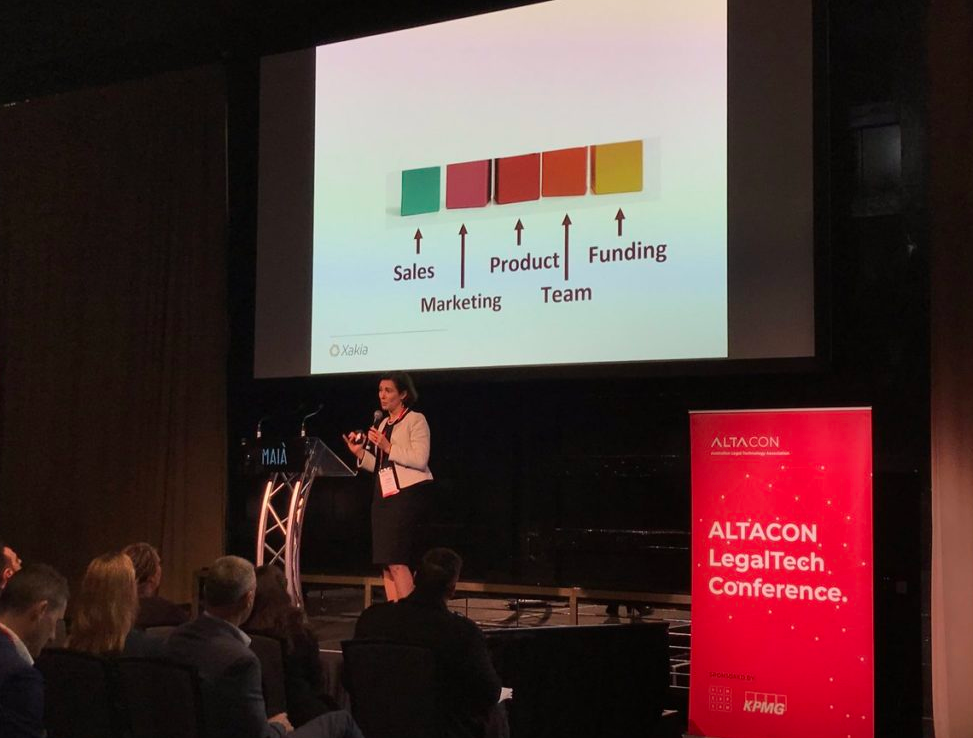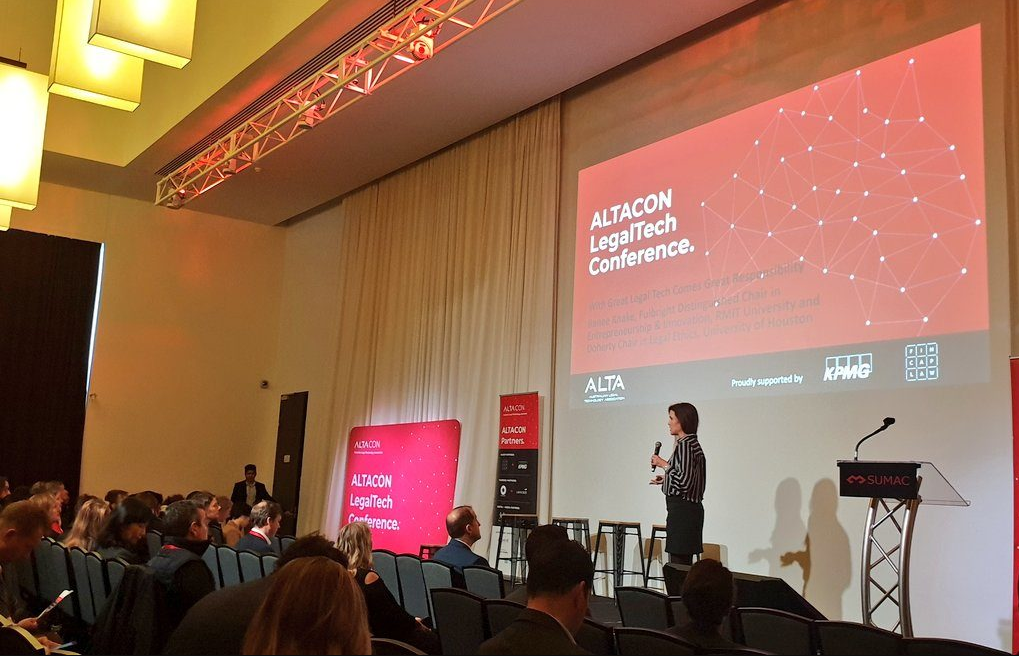- |
- |

I recently attended the inaugural ALTACON conference in Melbourne. Running over a single day, it was packed to the brim with keynotes and expos on the unique cross-section between legal, design thinking, and technology.
Kicking off on a Friday at 9am, I had a feeling the conference would provide plenty of inspiration and insights to end the week. Hosted by ALTA, the day turned out to offer so much more, with thought provoking insights and presentations that will undoubtedly swirl around in many peoples’ thoughts for some time to come.

A full conference room, ready to dive into legal (Image courtesy of ALTACON 2019).
ALTA is the Australian Legal Technology Association. A relatively new organisation, it brings together a community of like-minded individuals, legal professionals, and businesses who are keen to share, collaborate, and build the presence of Australian legal technology globally. Sounds awesome doesn’t it?
If you’re wondering why I chose to attend a legal tech conference in the first place, it’s because Australia isn’t traditionally known for this type of work. That reputation is changing though, and fast.
We’ve been working with Hive Legal to execute legal design thinking in the space of privacy compliance. One of our latest projects is our own privacy policy.
There’s been a significant amount of interest in this work and demand for output which is wonderful. Organisations want to ensure their policies are not only legally compliant, but easier to understand for anyone accessing them.

I had the golden ticket, and I was ready to nerd out in my very own version of Willy Wonka’s Chocolate Factory.
To keep this excitement and knowledge sharing going, I’ve summarised a few talking points from the moments that really stood out for me at ALTACon.
9am: cross-pollination over morning coffee.
Coming together: transforming legal through community, cross-pollination and platform.
The morning kicked off with a thought-provoking keynote from Christian Lang. An experienced lawyer who now focuses on strategic consulting for Reynen Court, Christian believes we are on the brink of… something. But what exactly is that something?
We are seeing levels of funding continue to increase within the space of legal technology. Large law firms, particularly in the US, are starting to take a more active role in this space than ever before.
No one wants to be left behind. But where are we all heading?
Christian distinguished a series of challenges he believes the legal profession faces when it comes to innovation.

Christian takes the stage (Image courtesy of ALTACON 2019).
Although I am a lawyer, I’m not practicing. So while I could relate to these challenges from the perspective of seeing, reading about, and learning about their impact as I keep up to date with the profession, I couldn’t directly relate to them from a lived experience.
What I found particularly interesting, is that these challenges are not location-centric. They clearly apply to the legal profession globally which, if you take an optimistic view, means a huge opportunity for change and growth is brewing.
In a nutshell, the key challenges are:
- Balkanization; the profession has a problem with working in siloes.
- Problem definition; when large law firms are investing in technology solutions and releasing them to the professional or commercial market, we often see these solutions searching for a problem to attach to. The legal profession is struggling to clearly articulate the problem/s that their tech solutions solve and why.
- Value stories; the legal innovation community, in particular, is struggling to tell stories about the value these solutions create. Cost-driven stories are the most common genre but that’s only one type of story. Legal innovations provide much more value than just cost savings.
The way through these challenges is to establish a community. Specifically, to encourage and drive diverse conversations that bring together multi-disciplinary teams.
Christian advocates for lawyers to genuinely share stories and value when it comes to discussing legal innovation. This type of work is not a zero sum game, it is not adversarial. It requires open and curious discussions in order to bring about change.
In our industry—the design and technology sphere—we are used to these types of conversations. We encourage learning within our agency teams. We promote sharing with our clients; sometimes we even give away too much.
The legal profession is changing and lawyers embracing legal innovation around the world seek to have more open, and better, conversations.
Participating in a multi-disciplinary team inherently changes communication habits, varies the types of ideas that contribute to solving a problem, and moves towards real transformative change.
As Christian mentioned, transformative change requires thought and problem solving at all points of the change journey, not just the end point solution. Herein lies the opportunity for the legal profession: to change the conversation, and to form and learn new habits.
It was only 10.30am and my mind was already overflowing with ideas about what’s possible for lawyers of the future.
11am: a presentation for when things go wrong (as they do).
LegalTech: War Stories and other disasters.
Following Christian’s presentation, I left the speaker sessions and ventured into the member stories hub of ALTACON.
Jodie is one of the founders of Hive Legal and gave an honest account of starting life as a software entrepreneur with Xakia Technologies.
Having worked in the technology space for a number of years, I found her story incredibly raw at times, while still shining with optimism.
Xakia is used extensively by in-house legal teams around the world. The platform helps lawyers operate more efficiently, gather insights, and map data trends about matters and workloads. It’s pretty powerful.
During the formative time of Xakia, Jodie and her partners consulted numerous lawyers to understand what kept them up at night. They believed their platform would solve a problem but they needed to be sure.

Jodie offers her insights (Image courtesy of ALTACON 2019).
I appreciated Jodie’s honesty in sharing her story. Her insights on building a company, and rebuilding—just when you think things are going smoothly—reminded me of Ryan Holiday’s book, ‘The Obstacle is the Way’.
Building a business isn’t about reaching paradise and settling in for an extended period of smooth sailing. It’s about overcoming obstacles. Every. Single. Day.
It was refreshing and inspiring to hear this story from a lawyer-turned-tech-entrepreneur. Our industry is filled with entrepreneurs pushing all kinds of ideas (some more viable than others), and it was a welcome contrast to hear some of the common challenges and unique experiences Jodie brought to the table within this growing space.
11:15am: a mid morning look at our duty to innovate.
With great legal tech comes great responsibility.
- Professor Renee Newman Knake
Fullbright Distinguished Chair in Entrepreneurship/Innovation 2019, RMIT University.
Professor Knake’s work primarily focuses on legal innovation with a regulatory angle. She is a well-known speaker, author, and consultant on legal ethics and legal innovation both in Australia and the US.

Food for thought from Renee (Image courtesy of ALTACON 2019).
A key aspect of Renee’s talk has stayed with me: do we as lawyers, have a duty to innovate?
In 2012, the American Bar Association modified its Model Rules to ensure that the duty of competence would not only apply to substantive knowledge of law, but also competent use of technology.
The Model Rules are a set of guidelines that each state in America can use or ignore to form their own rules for the professional conduct of lawyers. As at the end of last year, approximately 34 states had adopted Rule 1.1 that contains the updated duty of competence.
Renee believes that lawyers do have a duty to innovate.
In order to meet the duty of competence and even to meet our ethical obligations, we must find new ways to solve problems and to better serve clients. We must keep changing and evolving how we think and use technology in the legal profession.
I started to wonder about this duty. If it remains a duty, is it just another form of encouragement to the profession? Can a duty be resented? Or, would it improve the collective intelligence of the profession and make us all better over time?
I’m not sure I have answers to these questions. I think the current groundswell of professionals operating in the legal tech space is only getting louder and larger.
So even if there is resentment or resistance towards change, it may well be overtaken by the curiosity and the need to embrace technology within the profession.
12pm: Finding ways to create value that’s accessible.
Where does competitive advantage lie? Exploring the value of legal design.
Meera is well-known in the legal design space as a prominent practitioner and proponent of using legal design thinking to create better solutions for clients, and our community. As a founder of Observ, she works with organisations and governments predominantly in Europe.
Her masterclass focused on design thinking within the legal profession. As we move in to 2020, the question begs to be asked, is focusing on tech within the legal profession enough?
There is a growing body of research to suggest lawyers need to develop stronger interpersonal, communication, and interpretation skills in order to remain competitive and relevant in the profession.
As yet, there is no specific definition when it comes to the concept of ‘legal design’. It is essentially, as Meera explained, just one approach to solving legal problems.
Design isn’t just for making legal information look beautiful. Illustrating this point, Meera used the word ‘legal’ in various typefaces to demonstrate the power of design and how it can evoke perception, positioning, and different meanings.
As designers, technologists, copywriters, and other creatives working in our industry, we are well-acquainted with the purpose and power of good design. While this part of the presentation wasn’t new for me personally, the audience reaction and participation was enlightening.
I think it’s often easy to underestimate the need to articulate the purpose of effective design and why it is so vital in making professions and our community better.
Design changes depending on the context and content. For lawyers, this can mean mitigating risk in how that content is communicated and whether the content is understood and accessible.
Meera highlighted a number of case studies that have effectively applied legal design to solving problems. One in particular stood out for me, especially with our presence and work in Manchester.
In 2016, the European Union published a directive that reflects Article 9 of the United Nations Convention of the rights of Persons with Disabilities. This directive ensures that people with disabilities have better access to the websites and mobile applications of public services.
Broadly, it encourages the European public sector to focus on web accessibility for everyone using their websites and mobile apps. Public organisations, with some exceptions, must provide a public accessibility statement on their website indicating their level of web accessibility. They must also provide a mechanism for users of their sites to provide feedback and report inaccessible content.
Creating these accessibility statements is not as simple as just writing a few lines and hoping for the best. If a public organisation is not currently at Level AAA of the Web Accessibility Content Guidelines (WCAG), they need to explain what level they are at, and why they believe they do not need to provide a Level AAA website experience based on the guidelines.
Meera and her team at Observ have been working with the Finnish government to develop a set of instructions for the creation of effective accessibility statements. Using legal design thinking, the Observ team are helping the Finnish government focus on purpose, empathy with the end user of these accessibility statements, and work towards an outcome that produces a higher level of understanding within the public sector.
So where to from here?
Legal technology and legal design thinking has the opportunity to help legal professionals create better client experiences, better access to justice, and better working lives for lawyers now and in the future. But we have to get on board and take the leap if we’re going to make it work.
Following ALTACON, I’ve been inspired with a fervor to keep exploring and contributing in the legal design thinking space.
I am so excited by our collaboration with Hive Legal. I know the work we are doing together is not only challenging for our team as well as theirs, but it’s ultimately about creating better experiences for our respective clients and their audiences.
After all, innovation in the law is, and should always be, about making the law easier to understand for everyone.
More Articles
Up for some more?
Get your monthly fix of August happenings and our curated Super8 delivered straight to your inbox.
Thanks for signing up.
Stay tuned, the next one isn't far away.
Return to the blog.
